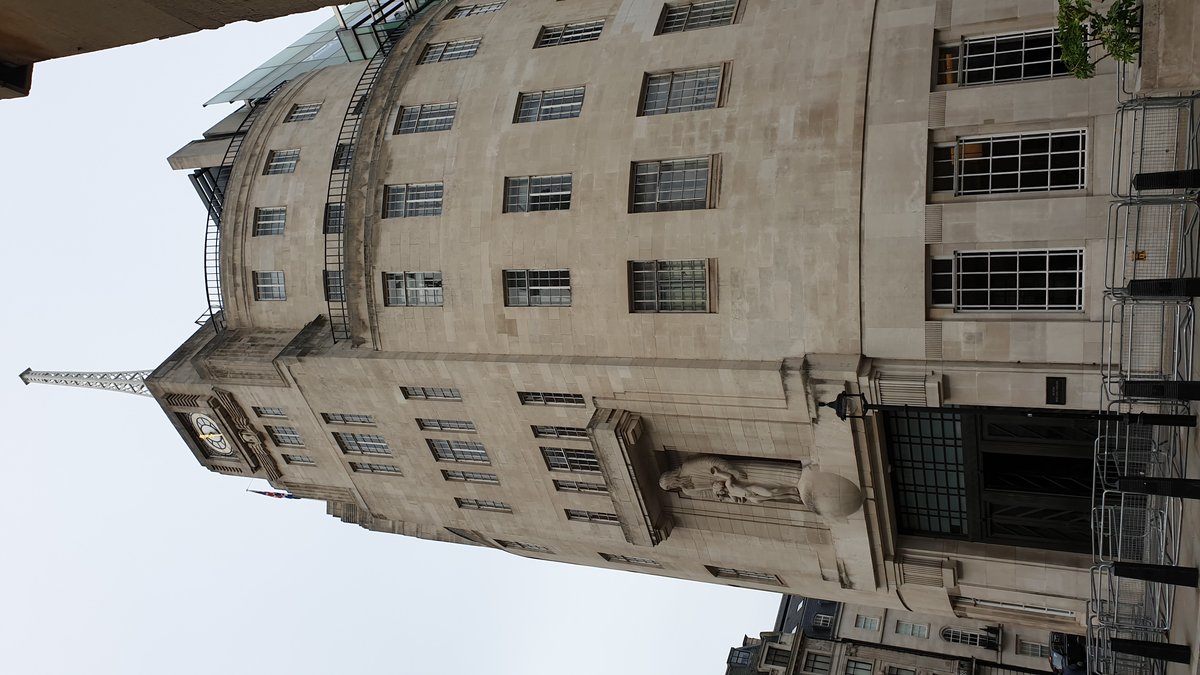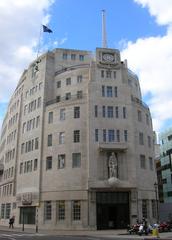
Broadcasting House London: Visitor Hours, Tickets, and Historical Sites Guide
Date: 14/06/2025
Introduction
Broadcasting House, the landmark headquarters of the British Broadcasting Corporation (BBC), stands as a monumental symbol at the intersection of British media history and architectural innovation. Located in the heart of London’s West End at Portland Place, this Grade II* listed Art Deco building has been a beacon of broadcasting since its official opening in 1932. It continues to play a vital role in shaping global media narratives, hosting world-renowned broadcasts, and representing the enduring legacy and innovation of British broadcasting. With its blend of history, culture, and modern media, Broadcasting House is an essential destination for visitors interested in London’s historical sites, media history, and architectural beauty.
This comprehensive guide outlines everything you need to know about visiting Broadcasting House: from its architectural and cultural significance to practical details on visiting hours, tickets, accessibility accommodations, nearby attractions, and insider tips for attending live recordings or exploring the BBC Radio Theatre. The guide also includes advice on etiquette, photography, and how to stay updated with the latest events. For up-to-date information, consult the official BBC Shows and Tours website and travel resources like Lonely Planet.
Table of Contents
- Introduction
- Architectural and Historical Significance
- Cultural and Media Impact
- Symbolism and Artistic Features
- Evolution and Modernization
- Visiting Broadcasting House: Practical Information
- Nearby Attractions and Photographic Spots
- Memorials and Public Engagement
- Visitor Etiquette and Tips
- Frequently Asked Questions (FAQ)
- Conclusion and Recommendations
- References
Architectural and Historical Significance
Broadcasting House was designed by architect George Val Myer and engineer M. T. Tudsbery as the UK’s first purpose-built broadcasting centre. Its distinctive Portland stone façade, curved frontage, and Art Deco details make it an unmistakable feature of London’s cityscape. Opened on 15 May 1932, the building originally included 22 studios, 800 doors, 6,500 lamps, 98 synchronized clocks, and 142 miles of broadcast circuit wiring. Interiors designed by Raymond McGrath reflected the elegance and efficiency of Art Deco, with specialized spaces for music, drama, and talks. The building was universally praised for its technical sophistication, described as “the brain centre of modern civilization.”
Cultural and Media Impact
Beyond its architectural allure, Broadcasting House serves as the operational hub of the BBC. Since the first daily radio broadcasts in 1922 and the move to Broadcasting House a decade later, the site has witnessed key moments in broadcasting history. Landmark events include the coronations of King George VI and Queen Elizabeth II, and the expansion of the BBC World Service, which broadcasts in over 40 languages. The building has played a pivotal role in global media, serving as a stage for historic broadcasts and the evolution of radio and television.
Symbolism and Artistic Features
A highlight of Broadcasting House is the Eric Gill sculpture of Prospero and Ariel above the main entrance, representing the magic and reach of broadcasting. The building’s mast and clock historically relayed the chimes of Big Ben, reinforcing the BBC’s role as the nation’s voice and timekeeper. These artistic features, along with the preserved Art Deco interiors, provide a unique visual narrative for visitors.
Evolution and Modernization
Over its long history, Broadcasting House has adapted to changing needs. It survived wartime damage and underwent substantial redevelopment in the 2000s, including restoration of the original building and the addition of the modern John Peel Wing and a new extension. Today, it houses the BBC’s largest live newsroom and integrates the BBC World Service, making it the largest creative media hub in London.
Visiting Broadcasting House: Practical Information
Location and Accessibility
Broadcasting House is located at Portland Place, W1A 1AA, central to London’s West End, between Oxford Street and Regent’s Park. The nearest London Underground stations are Oxford Circus (Bakerloo, Central, and Victoria lines) and Regent’s Park (Bakerloo line). Multiple bus routes serve the area (Lonely Planet). Facilities are fully accessible, including step-free entry, accessible restrooms, and hearing loops.
Visiting Hours and Tickets
- Foyer and BBC Shop: Open Monday to Friday, 9:00 AM–5:00 PM; closed on weekends except for live recordings.
- Guided Tours: Tours are typically available by advance booking only, running 10:00 AM–4:30 PM. Walk-ins are not accepted.
- Live Recordings: Free tickets for live recordings at the BBC Radio Theatre are available via the BBC Shows and Tours website.
- Ticket Prices: Adults £13.75, Children (9–15) £9.25, Students £10.25, Family £40.00. Children under 9 are not permitted on tours (BBC Shows and Tours).
Guided Tours and Special Events
Guided tours provide behind-the-scenes access to historic and modern studios, the BBC newsroom, and the Radio Theatre. Highlights include interactive experiences (such as reading news bulletins), learning about the BBC’s evolution, and occasionally observing live broadcasts (Free Tours by Foot). Special events and exhibitions are hosted throughout the year.
Travel Tips
- By Tube: Oxford Circus and Regent’s Park stations are a short walk away.
- By Bus: Numerous routes serve Portland Place.
- By Car: Metered parking is available but limited; there are no dedicated BBC parking facilities.
- Nearby Amenities: The West End location provides easy access to cafés, shops, and parks.
BBC Shop and Media Café
The BBC Shop offers a range of branded gifts, books, and memorabilia, and provides a unique view of the BBC newsroom through floor-to-ceiling windows. The Media Café is open to all visitors, offering refreshments and a vantage point overlooking the newsroom.
Accessibility
Broadcasting House is wheelchair accessible, with ramps, lifts, and accessible restrooms. Visitors with additional needs are encouraged to contact the BBC in advance for tailored support (BBC Media Café Information). Free Wi-Fi is available in public areas.
Notable Features and Photographic Spots
- Eric Gill Sculpture: Above the main entrance, depicting Prospero and Ariel.
- Dalek Statue: Near the entrance, a favorite with Doctor Who fans (Lonely Planet).
- Architectural Contrast: The blend of Art Deco and modern glass extensions.
- Public Art: The restored foyer features original geometric motifs and period lighting.
Memorials and Public Engagement
The John Peel Wing houses a memorial to BBC staff who have died in the line of duty. Public engagement continues through live broadcasts and special events in the BBC Radio Theatre.
Nearby Attractions
Thanks to its central location, Broadcasting House is an excellent starting point for exploring:
- All Souls Church: Adjacent, designed by John Nash.
- BT Tower: A former telecommunications landmark with panoramic views.
- Pollock’s Toy Museum: Showcasing a historic toy collection.
- Handel & Hendrix in London: Homes of composer Handel and guitarist Hendrix.
- The Wallace Collection: Renowned free-entry art museum.
- Oxford Street and Regent’s Park: Premier shopping and green space nearby.
Visitor Etiquette and Practical Tips
- Security: Bag checks and photo ID required for tours and live recordings.
- Photography: Permitted in public spaces and exterior, but not inside studios or during broadcasts.
- Dress Code: Smart-casual recommended, especially if attending live recordings.
- Food and Drink: Only allowed in the Media Café or designated areas.
- Plan Ahead: Book tickets in advance and check event schedules online.
- Crowds: Visit early or late in the day to avoid peak times.
- Weather: London weather is changeable; bring layers and rain protection.
- Transport: Use Oyster or contactless cards for bus and Tube. Avoid rush hours when possible (Happy to Wander).
Frequently Asked Questions (FAQ)
Q: What are Broadcasting House’s visiting hours?
A: Generally, Monday–Friday, 9:00 AM–5:00 PM; tours run 10:00 AM–4:30 PM. Check the BBC Shows and Tours website for current details.
Q: How do I book tickets for tours or live recordings?
A: Tickets must be pre-booked online via the BBC Shows and Tours website.
Q: Is Broadcasting House wheelchair accessible?
A: Yes. The building and public areas are fully accessible.
Q: Can I take photographs inside?
A: Photography is allowed in public spaces; not permitted inside studios or newsroom.
Q: Are children allowed on tours?
A: Tours are suitable for ages 9 and above.
Q: Are there cafés or shops on site?
A: Yes, the Media Café and BBC Shop are open to visitors.
Conclusion and Recommendations
Broadcasting House stands as a living testament to the evolution of British media and culture. Its pioneering Art Deco design, role in global broadcasting history, and ongoing contributions to news and entertainment make it an indispensable stop for anyone exploring London’s historical and cultural landscape. Whether you are admiring the architecture, shopping for BBC souvenirs, or attending a live recording, your visit will be both educational and memorable.
Key recommendations:
- Book tickets in advance via the BBC Shows and Tours website
- Check for special events or live recordings to enhance your visit
- Explore nearby attractions for a full day out in London’s West End
- Respect the BBC’s role as an active workplace by following etiquette guidelines
For the latest updates, exclusive content, and travel tips, download the Audiala app and follow our social media channels.
References
- BBC Shows and Tours – Official Site
- BBC Shows and Tours – Tour Information
- Lonely Planet – Broadcasting House
- Free Tours by Foot – Visiting the BBC
- BBC Media Café Information
- Happy to Wander – London Travel Tips




















































































































































































































































